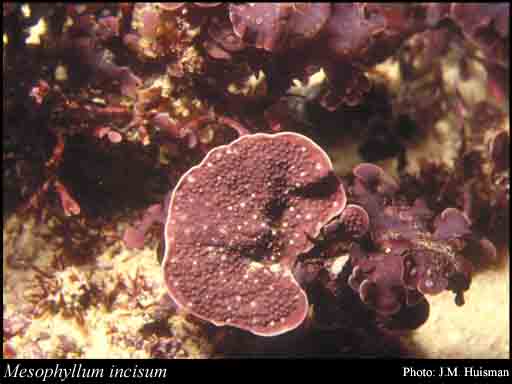- Reference
- Kongel.Danske Vidensk.-Selsk.Skr. 24 (1970)
- Conservation Code
- Not threatened
- Naturalised Status
- Native to Western Australia
- Name Status
- Current

Scientific Description
Habit and structure. Thallus normally pinkish, encrusting to warty, lumpy, discoid, layered or foliose, mostly 2–200 mm across and 0.04–12 mm thick or tall, epigenous and partially to completely affixed by cell adhesion; protuberant branches simple, mostly 0.8–12 mm in diameter and 0.5–12 mm long; lamellate branches applanate to ascending or upright, often layered, mostly 3–23 mm across and 2–7 mm long. Structure pseudoparenchymatous, organisation dorsiventral in crustose portions and lamellate branches but radial in protuberant branches; construction monomerous, consisting of a single system of branched, laterally cohering, filaments that collectively contribute to a ventrally or centrally situated core and a peripheral region where portions of core filaments or their derivatives curve outwards towards the thallus surface; each filament composed of cells 5–15 µm in diameter and 7–35 µm long; epithallial cells 5–12 µm in diameter and 5–10 µm long, terminating most filaments at the thallus surface, with distal walls rounded or flattened but not flared; cell elongation occurring mainly within actively dividing subepithallial initials that are usually as long as or longer than their immediate inward derivatives; cells of adjacent filaments joined by cell-fusions; trichocytes occasional, solitary or in small fields; secondary pit-connections and haustoria unknown.
Reproduction.Vegetative reproduction unknown. Gametangia and carposporophytes produced in uniporate conceptacles; tetrasporangia and bisporangia produced in multiporate conceptacles. Gametangial thalli monoecious or dioecious; carpogonia and spermatangia produced in separate conceptacles. Carpogonia terminating 2- or 3-celled filaments arising from the female conceptacle chamber floor. Mature female-carposporangial conceptacle roofs protruding above surrounding thallus surface, 75–185 µm thick, composed of 6–15 layers of cells above the chamber, conceptacle chambers 270–450 µm in diameter and 75–240 µm high. Carposporophytes lacking a conspicuous central fusion cell and apparently consisting of an irregularly shaped fusion cell that may look discontinuous in section and several-celled gonimoblast filaments bearing terminal carposporangia 25–155 µm in diameter. Spermatangial filaments unbranched, arising from the floor, walls and roof of male conceptacle chambers; mature male conceptacle roofs protruding above surrounding thallus surface, 45–90 µm thick, composed of 5–9 layers of cells above the chamber; conceptacle chambers 190–330(–420) µm in diameter and 50–120 µm high. Tetrasporangial/bisporangial conceptacle roofs protruding above surrounding surface, not differentiated into a peripheral rim and a central sunken pore-plate, 4–7 cells thick above the chamber; pore canals lined by cells (especially near the base of the canal) that are narrower and more elongate than adjacent roof cells; conceptacle chambers 340–655 µm in diameter and 130–265 µm high; tetrasporangia scattered across the conceptacle chamber floor; each mature sporangium 55–130 µm in diameter and 130–220 µm long, containing zonately arranged tetraspores and possessing an apical plug that blocks a roof pore prior to spore release; bisporangia occasional, 62–130 µm in diameter and 121–205 µm long.
Distribution.New Zealand, Chatham Islands, Snares Islands, Auckland Islands. InAustralia, from East Strickland Bay, Rottnest I., W. Aust., to Waterloo Bay, Wilsons Promontory, Vic., and around Tas.
Habitat. M. incisum has been found intertidally on reef surfaces and in pools and subtidally to depths of 15 m in southern Australia. It occurs on rock, sponges, and various algae.
[After Womersley, Mar. Benthic Fl. Southern Australia IIIB: 197–199 (1996)]
Distribution
- IMCRA Regions
- Central West Coast.